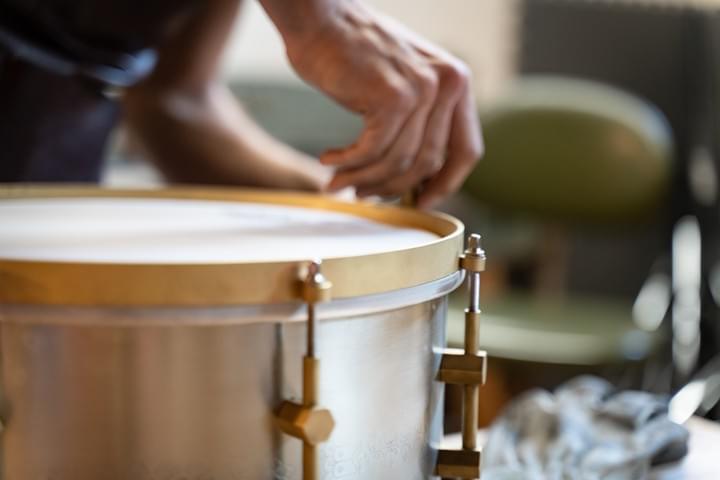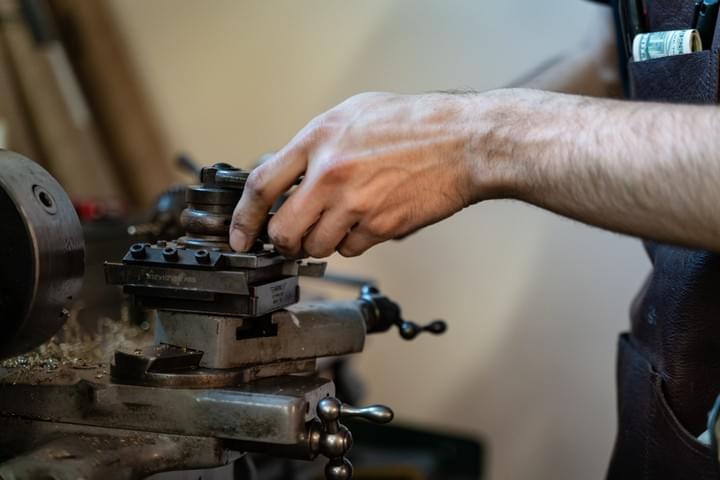
DESIGN

SHELLS
Nickel Silver Edition:
Nickel Silver is an old trade name for a special brass alloy with an unusually high nickel content in the mix. It's also known as German Silver, Nickel Brass, or Paktong. It is NOT "NOB," nickel over brass… it's nickel IN brass. Today, it’s an unusual alloy, and it is a challenge to source in sheet big enough to build drums. As best I can tell, only two mills in the world, one in Eastern Europe and another in Southeast Asia, produce it in the form necessary for a drum.
Today, it's used in high-end resonator guitars and French horns.
As far as I can tell, my Nickel Silver Edition are the first drums built from it. I think no one has tried it on a drum before because, well to be honest, apart from the lovely sound and look, Nickel Silver features the most annoying and frustrating fabrication characteristics of brass and stainless steel, combined! It’s as difficult as many stainless steels to cut and work, and fights like hell if you try to bend it… then expands and moves even more than regular brass when heated and welded/braised. It’s not easy. But, I think it’s worth it.
It’s both slightly lighter and stiffer than the yellow brass alloys traditionally used in drum building, which lets me achieve some real “holy grail” qualities in the design. In short, I can build a shell that’s thin enough but stiff enough to project and be structurally sound, or thin but still moves and sings at all dynamics. After much prototyping, I’ve settled on an initial shell offering that is a “straight shell” (no flanges), with a very specific “full contact” bearing edge profile. They also have a special snare bed that adds just a hint of chunky, vintage heft to an otherwise modern, wide and shallow design.These drums are dark, dry, and full of an aggressive midrange character, but controlled under the microphone.

HARDWARE
eLUGS are hand-machined from solid brass. There’s no big air cavity. They’re heavy. I firmly believe that the trend towards “low-mass” hardware sometimes overlooks fundamental truths about how drums operate as a system. These heavy lugs and hoops add a bit of focus to an otherwise very lively drum, while still resonating WITH it.
Know the classic drum co demo video, where they strip a shell naked and whack it with a mallet to show you how “resonant” it is? Great idea. IF you tend to take all the hardware off of your shells and play them like a marimba. And I’ve played some really out free jazz gigs, but I can’t say I’ve ever done that, and it doesn't feel like a useful metric to me, because it ignores that all components must work together.
The other day, I was putting a drum together and bumped a shell with its lugs ON, and you know what? It rang like a church bell. That’s what I’m going for. There’s no air pocket, and they’re an alloy that resonates not dissimilarly from the shell itself. If your leg is resting up against the lug or shell, you feel it singing on 2 and 4.
HOOPS are painstakingly handmade, as well, out of 3.2mm thick brass. If you’ve ever had the pleasure of playing heavy brass hoops on the select vintage drums that have them, you know what a joy this type of hoop is to play. The “brass-ness” and straight profile of them, balanced with the super thick construction, gives them a great balance of control and openness, with a rimshot/cross stick heft and feel that still gives me a smile every time I crack that first rimshot. They're not exactly "halfway between flanged and diecast"; they really exist on their own continuum.
FASTENERS, including both lug fasteners and tension rods, are stainless steel. No rust, now or ever.
TENSION RODS are not "off the shelf" tension rods, and you can't buy them elsewhere: they are machined to my exact specifications, including special details that resist detuning, important for a tube-lug drum. WASHERS are also made to my particular specification, and are of a thicker than standard "chubby" design that is a joy to tune (and feels nostalgic to those who have owned certain American-made vintage drums).

FINISH
Lacquers and polyurethanes offer bright, shiny, perfect finishes... that neither lasts nor age in an interesting, graceful manner. Particularly on brass, all lacquer eventually fails, scratches, or chips, with limited repairability and a harsh look.
Personally, I'm also not in love with the "pre-distressed, pre-created patina" aesthetic. I embrace and love patination, but only truly carries a depth, gravitas, and soul when it is real; when it is worn and won on the road and in the studio, going in and out of cases:...a fingerprint, from the condensation on the whiskey glass the bartender handed you on the house, as thanks for that last tune as they closed up
...a little fine scratch, from a bump into the rack tom, as an enthusiastic child hops behind the set, elated to learn their first beat.
That sort of patina, a true record of live lived and music made, is honesty in physical form I believe in embraching. For this, Latos metal shells and hardware are treated with a museum-grade conservators' wax. It imparts a warm lustre, and protects the drum's surface from dramatic fingerprints while it develops an initial layer of oxidation. It does eventually wear off after the shell and hardware have "stabilized" and developed an even more deep, rich, timeless and elegant color that bears wear and life honorably.

CRAFT
All the great design and top-shelf materials in the world don't mean a thing without execution.
Latos Drums are hand-crafted in Newburgh, NY, in my workshop-studio. Lugs are machined on an 80-year-old metal lathe; shells and hoops are manually rolled, sheared, and traditionally brazed. Decorative designs, such as our Art Nouveau banding, are birthed through collaboration with truly world-class designers, and lovingly etched in a labor-intensive process.Latos' stand-alone snare strainers feature components crafted with care in a small, close-knit CNC machine shop. These components are then inspected and undergo final machining and finish work in Latos' NY workshop, right alongside the high-end drums, and receive the same level of quality control.
A graceful marriage of traditional craftsmanship and modern design, these drums and components show the craftsman's hands, care, and love.
I believe in doing things mindfully, with deep consideration, and using my hands to leave a legacy, both behind the drumset as well as building these instruments. And I truly believe it shows.
Latos Drums
11 Spring St
Newburgh, NY 12550




